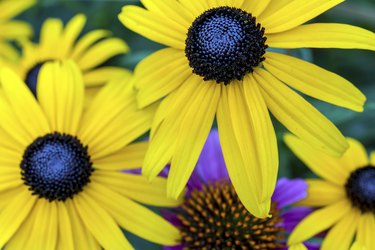
Common sunflowers (Helianthus annuus) and black-eyed Susans (Rudbeckia spp.) may easily be mistaken for one another, as both plants bloom in summer with bright yellow flowerheads marked in the center by dark brown disks. There are plenty of differences between the plants, however. Identifying each plant's features allows you to figure out how best to utilize them in the home garden.
Sunflowers Are Larger
Video of the Day
Sunflowers tend to grow taller than black-eyed Susans, generally reaching heights between 3 and 10 feet tall, with some varieties growing as high as 16 feet. Black-eyed Susans tend to be low-growing, with a bushy habit. Common black-eyed Susan species, such as Rudbeckia fulgida (USDA zones 3-9) and Rudbeckia hirta (zones 3-8), grow to be about 3 feet tall, with a similar spread.
Video of the Day
Black-eyed Susans have small, raised discs in the center of flowerheads, while sunflowers have larger, flatter discs. Sunflowers also have wide, large leaves that are rough to the touch and triangular, while black-eyed Susans have narrow, oblong or lance-shaped leaves.
Black-Eyed Susans May Live Longer
Though there are perennial sunflowers, most ornamental garden sunflowers are annuals and may be cultivated during the growing season anywhere in U.S. Department of Agriculture plant hardiness zones 2 to 11. They will perish once frosts strike in autumn. Black-eyed Susan species include both annuals and perennials.
Sunflowers Are Edible
Sunflowers produce edible seeds that may be harvested at the end of each flowerhead's life and eaten either raw or roasted. Although many bird species relish the seeds of black-eyed Susans, these seeds aren't palatable to people.
Sunflower seeds can be harvested by cutting off the flowerheads once the backs have turned from green to yellow and letting them dry out in a dry, warm place. The yellow petal-like florets on sunflowers are also edible and may be eaten raw as a garnish.
Leave black-eyed Susan flowers on plants to dry and provide a food source for many songbirds in late summer through winter. You'll enjoy watching many birds clasp the flower stems as they eat the seeds.
Black-Eyed Susans Tolerate Wind
Black-eyed Susans and sunflowers have similar cultural preferences, with both preferring well-draining, moist soils and full sun exposure. Black-eyed Susans are tolerant of strong wind, however, while sunflowers tend to develop tattered foliage in windy situations.
Sunflowers over 3 feet tall should be loosely tied to a stake to keep them from falling over. Black-eyed Susans are often massed together rather than grown as specimens and do not have a growth habit that mandates staking. Perennial black-eyed Susans may be divided in the spring to increase vigor.
Additional Differences — and Similarities
The sunflower is the state flower of Kansas and a member of the aster family (Asteraceae). It is also said that the heads of sunflowers follow the sun, which is true of many types of sunflowers, although some sunflowers remain stationary without following the sun. It's the process called heliotropism that causes the flowers and leaves to move toward the light.
The black-eyed Susan is the state flower of Maryland and is also a member of the aster family (Asteraceae). There are more than two dozen species of black-eyed Susans that are native to different parts of North America. Both sunflowers and black-eyed Susans attract a variety of pollinating insects, including butterflies and bees.
- Missouri Botanical Garden: Helianthus annuus
- Missouri Botanical Garden: Rudbeckia fulgida
- The Old Farmer's Almanac: Growing Black-Eyed Susans
- Lady Bird Johnson Wildflower Center: Helianthus annuus
- University of Illinois Extension: Sunflowers
- Plants for a Future: Rudbeckia hirta - L.
- Burpee: All About Sunflowers
- Texas AgriLife Extension Service: Sunflowers - Enjoy the Flowers....Give Birds a Treat
- University of Maryland Extension: Black-Eyed Susan
- American Meadows: All About Black-Eyed Susan
- U.S. Forest Service: Attracting Pollinators to Your Garden Using Native Plants